Kylfings – Unknown Warriors Mentioned On Norse Runes – Were They Members Of The Varangian Guard?
Ellen Lloyd - AncientPages.com - Several Norse runes mention a group of unknown warriors named Kylfings. According to scholars, the Kylfings may have been members of the Varangian Guard, but who these people were and where they came from remains a historical mystery.
Left: Norway's first king Harald Fairhair. Credit: Public Domain - Right: Battle of Hafrsfjord by Ole Peter Hansen Balling, 1870. Credit: Public Domain
Who Were The Kylfings?
From the late ninth century to the early twelfth century, the Kylfings were present in Northern Europe during the Viking Age.
They are mentioned in the Norse runestones, sagas, poems, Byzantine records, and Rus' law codes. The Kylfings obviously played an important role in many countries, but tracing these peoples' history has been difficult.
To begin with, we don't even know whether the term Kyfling refers to a particular tribe or is the name of a socio-political or economic group. Some scholars have suggested that the word kylfing was probably derived from Old Norwegian kylfa' club', which means 'man with a club.'
The Norslunda Runestone, bearing runic inscription U 419, mentions the personal name Kylfingr. Credit: Wikipedia
However, whether the Kylings were ethnically Finnic or Norse is still debated. They could have originated from Denmark, Sweden, or the Eastern Baltic.
The Kylfings And Their Battle Against Viking Chief Harald Fairhair
According to the Sagas, the Kylfings opposed the consolidation of Norway under the Viking chief Harald Fairhair.
The Kylfings participated in the great naval Battle of Hafrsfjord, sometimes between 872 and 900. When Harald Fairhair won the battle, the Kyflings started raids in Northern Norway and fought against King Harald Fairhair's warriors. The monument Sverd I Fjell – Swords In Rock, located just outside Stavanger, Norway, commemorates the Battle of Hafrsfjord.
Egil's Saga reveals that Kylfings were trading and plundering in Finnmark around 900. Thorolf Kveldulfsson, King Harald's tax agent in northern Norway, engaged Sami scouts to monitor the Kylfings' movements and report back to him. When Thorolf Kveldulfsson encountered the Kyflings, he killed all of them.
"Far and wide about Finmark did he travel; but when he reached the fells eastward, he heard that the Kylfings were come from the east and were there for trading with the Finns but in some places for plunder also.
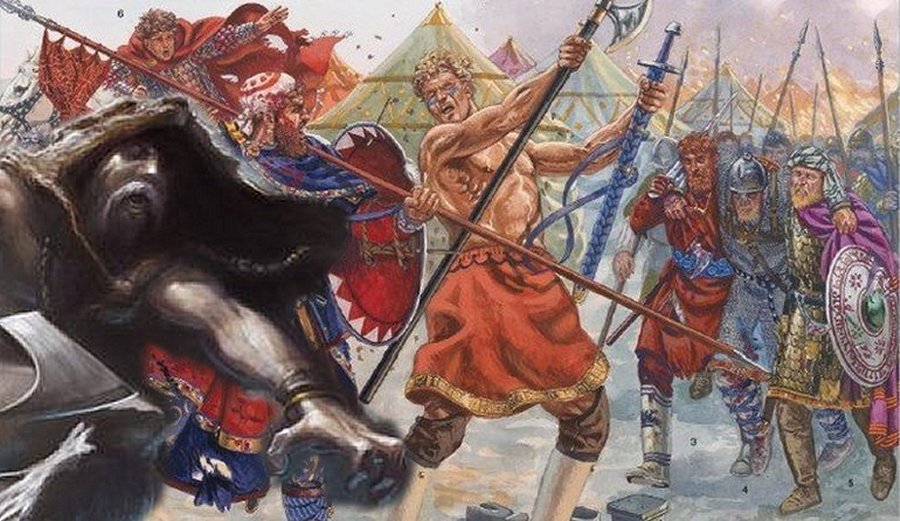 Roman Empire needed berserker warriors and hired them among northern mercenaries or in other places in Europe. Read more
Roman Empire needed berserker warriors and hired them among northern mercenaries or in other places in Europe. Read more
Thorolf set Finns to spy out the movements of the Kylfings, and he followed after to search for them and came upon thirty men in one den, all of whom he slew, letting none escape." (Egil's Saga, Chapter: Thorolf in Finmark)
Kyflings And The Varangian Guard
Historians have found evidence that the Kylings were also mentioned in connection with the Varangian Guard. The Varangian Guard represented the elite heavy infantry regiment of the Roman ('Byzantine') Empire from AD 988 AD to around 1404 AD. and consisted of professional Viking warriors who successfully conquered territories.
However, whether the Kyflings actually served as a unit of the Byzantine army has not been historically proven.
Who these unknown warriors were and where they came from is still a controversial subject. One theory proposed they were a Finnic tribe or West Slavic people. Still, many have also suggested that the Kylfings were from East Scandinavia, possibly Swedish tribe, or originated from eastern Baltic and northern Russia.
Written by Ellen Lloyd – AncientPages.com
Updated on October 2, 2022
Copyright © AncientPages.com All rights reserved. This material may not be published, broadcast, rewritten or redistributed in whole or part without the express written permission of AncientPages.com
Expand for referencesSaga Och Sed: Kungl. Gustav Adolfs Akademiens Årsbok
P. Sture Ureland, Iain Clarkson - Scandinavian Language Contacts
Egil's Saga
More From Ancient Pages
-
 Mysterious Vanishings Around The Azores And The Riddle Of The ‘Cosmic Brain’ Influence
Featured Stories | Feb 8, 2019
Mysterious Vanishings Around The Azores And The Riddle Of The ‘Cosmic Brain’ Influence
Featured Stories | Feb 8, 2019 -
 Ancient Manuscript And Controversial Ancient Book Shed New Light On The Mystery Of The Toltecs
Ancient Mysteries | Sep 9, 2018
Ancient Manuscript And Controversial Ancient Book Shed New Light On The Mystery Of The Toltecs
Ancient Mysteries | Sep 9, 2018 -
 Grolier Codex – Oldest, Unique, Genuine Pre-Columbian Maya Manuscript That Survived Spanish Inquisition
Artifacts | Jan 20, 2018
Grolier Codex – Oldest, Unique, Genuine Pre-Columbian Maya Manuscript That Survived Spanish Inquisition
Artifacts | Jan 20, 2018 -
 New DNA Study Links Early Europeans’ Cultural And Genetic Development Over Several Thousand Years
Archaeology | Aug 9, 2023
New DNA Study Links Early Europeans’ Cultural And Genetic Development Over Several Thousand Years
Archaeology | Aug 9, 2023 -
 Jack The Ripper Letter Mystery Solved By Forensic Linguist
Archaeology | Feb 1, 2018
Jack The Ripper Letter Mystery Solved By Forensic Linguist
Archaeology | Feb 1, 2018 -
 Chinese Writing System – Increasingly Complex Over The Course Of Its 3000-Year History
Linguistic Discoveries | Nov 23, 2022
Chinese Writing System – Increasingly Complex Over The Course Of Its 3000-Year History
Linguistic Discoveries | Nov 23, 2022 -
 Millennium Old Dice Found In Vadnagar, Gujarat, India
Archaeology | Apr 25, 2022
Millennium Old Dice Found In Vadnagar, Gujarat, India
Archaeology | Apr 25, 2022 -
 Hidden Text Discovered Inside Ancient Scroll
Archaeology | Oct 5, 2018
Hidden Text Discovered Inside Ancient Scroll
Archaeology | Oct 5, 2018 -
 Draken Harald Hårfagre – World’s Largest Viking Ship On Its Way To U.S And Canada
News | Apr 27, 2016
Draken Harald Hårfagre – World’s Largest Viking Ship On Its Way To U.S And Canada
News | Apr 27, 2016 -
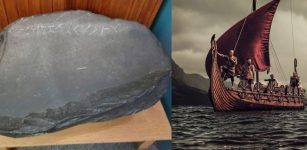 Does Yarmouth Runic Stone Describe A Trans-Atlantic Viking Voyage?
Artifacts | Oct 22, 2018
Does Yarmouth Runic Stone Describe A Trans-Atlantic Viking Voyage?
Artifacts | Oct 22, 2018 -
 Mysterious Underground City In Brazil Could Re-Write Ancient History – Unexplained Artifacts And Skeletons – Part 1
Ancient Mysteries | Jan 23, 2022
Mysterious Underground City In Brazil Could Re-Write Ancient History – Unexplained Artifacts And Skeletons – Part 1
Ancient Mysteries | Jan 23, 2022 -
 What Was Life Like For Children In Ancient Athens?
Ancient History Facts | Jul 4, 2018
What Was Life Like For Children In Ancient Athens?
Ancient History Facts | Jul 4, 2018 -
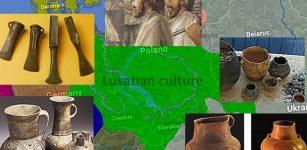 Lusatian Culture: Ancient Traders Of Central Europe Built Strongly Fortified Settlements To Withstand Scythian Attacks
Civilizations | Jan 27, 2024
Lusatian Culture: Ancient Traders Of Central Europe Built Strongly Fortified Settlements To Withstand Scythian Attacks
Civilizations | Jan 27, 2024 -
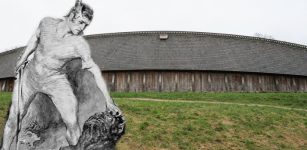 Lejre Viking Hall And Beowulf – What Is The Connection?
Featured Stories | Jun 3, 2024
Lejre Viking Hall And Beowulf – What Is The Connection?
Featured Stories | Jun 3, 2024 -
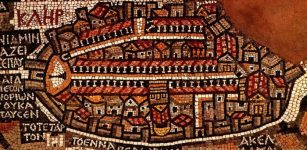 Stunning Madaba Map: Oldest Known Mosaic Built Of Two Million Stone Cubes
Civilizations | Jun 16, 2017
Stunning Madaba Map: Oldest Known Mosaic Built Of Two Million Stone Cubes
Civilizations | Jun 16, 2017 -
 Controversial Sand Mounds In Australia Are 6,000 Years Old Man-Made Burial Mounds – Radar Scans Reveal
Archaeology | Feb 10, 2018
Controversial Sand Mounds In Australia Are 6,000 Years Old Man-Made Burial Mounds – Radar Scans Reveal
Archaeology | Feb 10, 2018 -
 Solstices Brought Mayan Communities Together, Using Monuments Shaped By Science And Religion – And Kingly Ambitions, Too
Featured Stories | Jul 6, 2024
Solstices Brought Mayan Communities Together, Using Monuments Shaped By Science And Religion – And Kingly Ambitions, Too
Featured Stories | Jul 6, 2024 -
 Enigmatic Figure Dated Back To 40,000 From Prehistoric Stadel Cave, Germany
Ancient Traditions And Customs | Sep 7, 2018
Enigmatic Figure Dated Back To 40,000 From Prehistoric Stadel Cave, Germany
Ancient Traditions And Customs | Sep 7, 2018 -
 Fascinating Altamura Man – One Of The Most Complete Neanderthal Skeletons Ever Discovered
Featured Stories | Jul 15, 2022
Fascinating Altamura Man – One Of The Most Complete Neanderthal Skeletons Ever Discovered
Featured Stories | Jul 15, 2022 -
 Neanderthal And Denisovan Blood Groups Deciphered And The Results Are Surprising
Archaeology | Aug 2, 2021
Neanderthal And Denisovan Blood Groups Deciphered And The Results Are Surprising
Archaeology | Aug 2, 2021


